|
BULB LOG 41 --- 11th October 2006
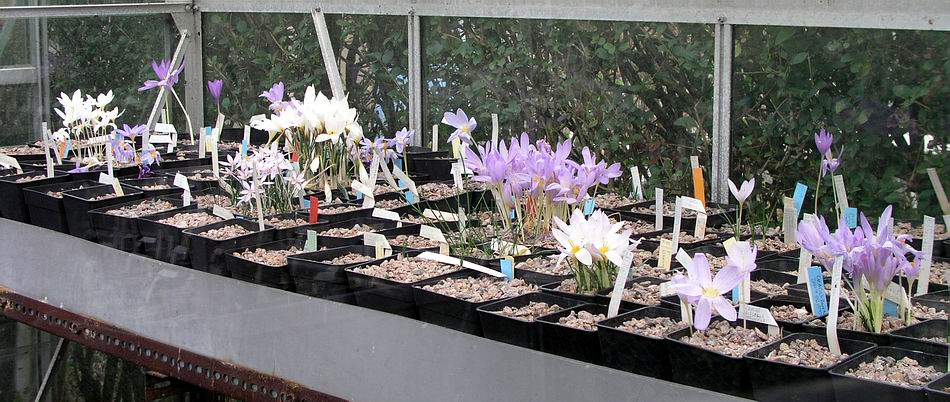
Autumn Crocus in the bulb house
We have just come back from a fantastic SRGC Discussion Weekend at Pitlochry where over 130 of us gathered to talk, buy and swap plants as well as having a great big party all weekend. If you have never been to one of our weekends you do not know what you are missing; it will be in Glasgow next year, watch out for booking details with the January Journal. Now back to the bulbs; when we left on Thursday a few crocus were in flower and by Monday this is the sight that awaited our return.
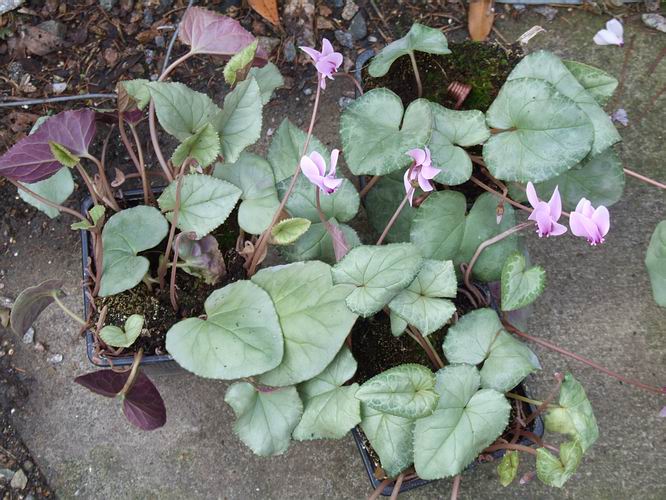
Silver leafed Cyclamen hederifolium
First I will show a few of the bulbs I bought at the weekend. I could not resist snapping up a few pots of these Silver leafed Cyclamen hederifolium plants. They all had a good silver grey leaf and I was trying to select out some with interesting shapes as well. I suspect that there is more than one corm in some of these pots as there is too much variation in the shape of the leaves to be coming from one.

Cyclamen mirabile
I will find out soon as I always wash off the roots of plants that come into the garden, bulbs included, and repot them into our own compost. This is one of several Cyclamen mirabile plants I also bought and you can see the good root system it has developed in the peaty compost it was growing in. These peaty composts are designed to work for the mass growers and they do the job extremely effectively but I need to get the plants into a compost that I have tailored to suit my cultivation methods and conditions.
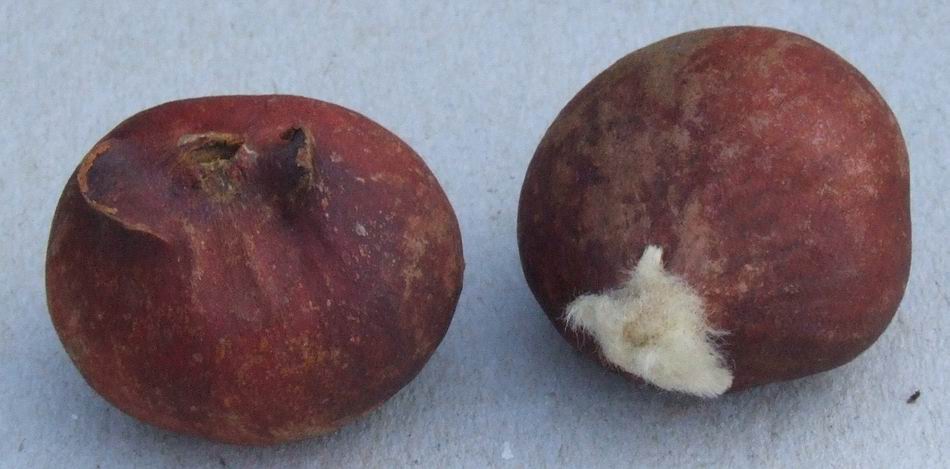
Tulipa clusiana
I also purchased some Tulipa clusiana bulbs, well I hope that they will turn out to be Tulipa clusiana but even if they are one of the commercial forms or hybrids I will not be disappointed. Notice the two 'feet' on the bottom of the bulb (left) and the woolly lining sticking out from the top of the tunic - like all bulbs they are fascinating structures finely tuned by thousands of years of evolution to suit the environment they grow in.

Crocus hadriaticus
Back to the bulb house and Crocus hadriaticus is now in full flower, there was a fine pot of this at the Discussion Weekend Show. It is a good reliable crocus capable of producing a number of flowers from each corm when it is growing well.
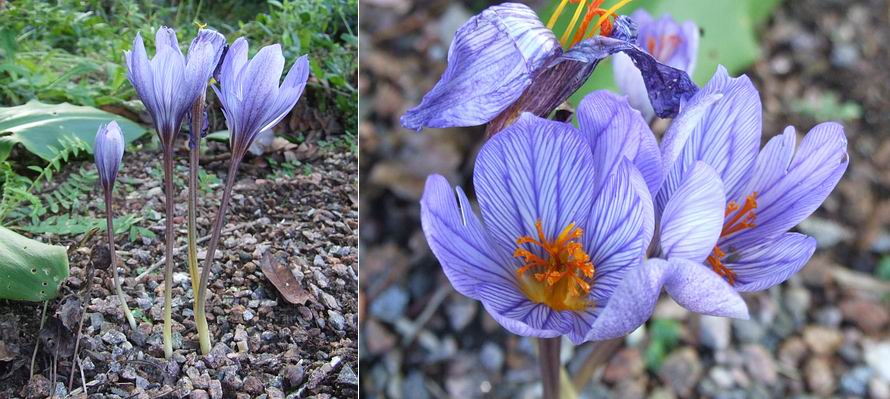
Crocus speciosus
Most of the autumn flowering crocus can also be grown in the garden but they are subjected to the rigors of the climate and slugs which, in Aberdeen, can devastate them almost as soon as they come out. Despite this we do grow a lot of them outside and this is the darkest form of Crocus speciosus we have - it was given to us a few years ago by Alastair Mckelvie, former Editor of the SRGC and now he is standing down from the Subscription Secretary's post, which he has held for several years; one of the hardest working volunteers in the Club, he deserves a rest.

Crocus speciosus xantholaimos
An interesting seedling of Crocus speciosus xantholaimos has produced an extra three petals giving it a very full look. If you look carefully, rising at six o'clock, is another petaloid form and this sort of mutation of producing extra floral segments is fairly common in the flowers of many bulbs. It is usually transient, caused by cell damage at an early stage of the flowers development and not repeated in future years. Occasionally it is caused by a genetic mutation and is a permanent feature giving us full doubles such as Colchicum 'Water Lily' shown in last week's log.

Crocus speciosus xantholaimos seedling
This is another variation that has come from a pot of Crocus speciosus xantholaimos seedlings, I am not sure if this is a result of crossing with some of the other forms or perhaps a stray seed from another crocus got mixed in. No matter how careful we try to be, when you grow so many plants as we do, mix ups are always going to happen.
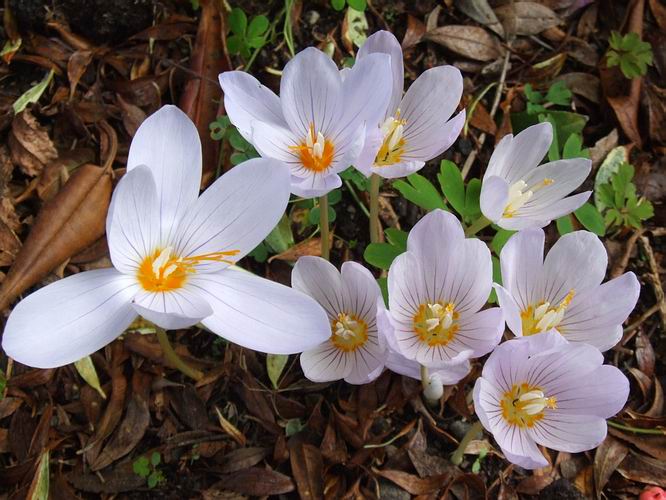
Crocus seedlings
Talking of mix ups this is a group of self sown seedlings in the garden showing some variation. The one on the left and the one just above it look to be the cross between Crocus pulchellus and speciosus while the others look like Crocus kotschyanus. Despite having very different corm tunics Crocus kotschyanus and C. pulchellus have very similar flowers which can easily cause confusion to all but the experts. Especially when you throw into the equation the hybrids between C. speciosus and pulchellus which are very common in the trade and gardens - all make fine plants.
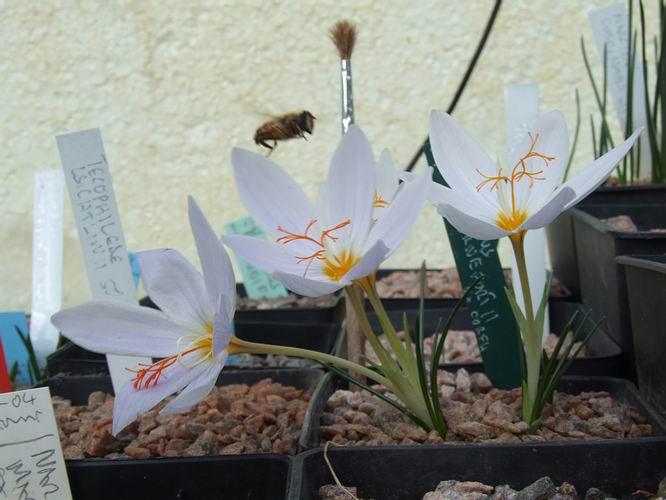
Crocus tournefortii
If you want to stand the best chance of getting seeds set on your Crocus you should not just leave the pollination to nature. Just as I was preparing to snap this Crocus tournefortii a bee manoeuvred into position and landed briefly on the flower at the back of this group before flying over to another part of the glasshouse to land on the flower of another Crocus species -it should be no surprise then when we get hybrids from our garden collected seed. Some species are incompatible and cannot fertilise each other while others cross freely and the true species are only preserved in their native habitats by being isolated from each other by geography. If you look at this picture again you will see two pollinators; one the bee and the other one of my trusty paint brushes with which I transfer the pollen from style to stigma in the hope of achieving the best seed set.

Crocus caspius
It is fascinating to speculate why these crocus flower in the autumn and one of the possibilities is that there is either less competition for, or there are simply greater numbers of, pollinating insects around at this time of the year than there is in spring. Having been successfully fertilised the bulb has now to keep its seed safe for almost an entire year - you may remember it was only a few logs ago that I showed the seed from Crocus caspius which I only found as I watered the pot and disturbed the gravel. This seed has been kept safe under ground since it was fertilised this time last year but not all autumn flowering bulbs have this adaptation.

Sternbergia sicula
The seed pod on a Sternbergia is at the top of the stem which sticks well above the ground and must be subjected to all sorts of threats from both the climate and animals before the seed eventually matures and ripens in the late spring. This by the way is one of the bulbs that I think is true Sternbergia sicula, if such a species does exist. It is distinct from the other plants I grow which came as sicula but are probably just a narrow leaved form of S. lutea. This form sends up its flower stem first, it is often at an angle, sometimes lying on the ground as seen above, the leaves emerge as the flower opens and they too are often prostrate to the ground. The flowers are much smaller and starry shaped than the large goblet shaped flowers of S. lutea.
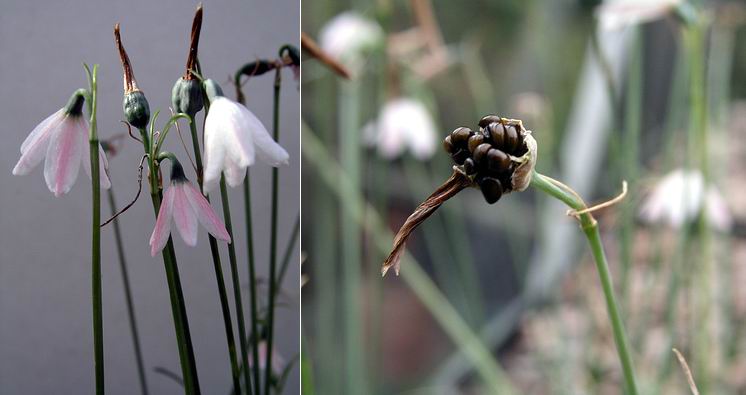
Leucojum roseum and seed
Leucojum roseum is the only autumn flowering bulb that I grow which ripens and sheds its seed within weeks of flowering - this you would think is a much more efficient method of survival than the sternbergia have adopted.
I will leave you this week with one of the daintiest of the autumn crocus.

Crocus cambessedesii.
If you want to see many more great pictures of the autumn crocus you should visit the forum pages on this website.
^ back to the top ^
|

